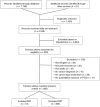Primary brain tumor representation in the post-traumatic growth literature: A scoping review
- PMID: 38222049
- PMCID: PMC10785581
- DOI: 10.1093/nop/npad058
Primary brain tumor representation in the post-traumatic growth literature: A scoping review
Abstract
Background: Post-traumatic growth (PTG) has been extensively explored within general oncology, yet little is known about the experience of PTG in neuro-oncology. This study aimed to determine the representation of patients with primary brain tumors (PBT) in the PTG literature.
Methods: PsycINFO, PubMed, and CINAHL were systematically searched from inception to December 2022. Search terms were related to personal growth and positive reactions to cancer. Articles were first screened by titles and abstracts, then full texts were reviewed using the Preferred Reporting Items for Systematic Reviews and Meta-Analyses method.
Results: A total of 382 articles met the inclusion criteria. Of those, 13 included patients with PBT. Over 100 000 cancer patients were represented, with 0.79% having a PBT. Most research focused on low-grade gliomas. PTG negatively correlated with post-traumatic stress symptoms and avoidant coping. In the sole longitudinal study, patients with PBT demonstrated improved PTG after 1 year. Three quasi-experimental studies investigated the effect of mindfulness-based interventions with mixed-cancer samples and demonstrated improvement in PTG.
Conclusions: The inclusion rate of patients with PBT in the PTG literature was significantly lower than the population prevalence rate (1.3% of cancer diagnoses). Relatively few studies focused exclusively on how patients with PBT experience PTG (k = 5), and those that did only included low-grade glioma. The experience of PTG in those with high-grade glioma remains unknown. Patients with PBT are scarcely included in research on PTG interventions. Few studies examined the relationship between PTG and medical, cognitive, or psychological characteristics. Our understanding of the PTG experience in neuro-oncology remains extremely limited.
Keywords: neuro-oncology; post-traumatic growth; primary brain tumor; scoping review.
© The Author(s) 2023. Published by Oxford University Press on behalf of the Society for Neuro-Oncology and the European Association of Neuro-Oncology. All rights reserved. For permissions, please e-mail: journals.permissions@oup.com.
Conflict of interest statement
The authors have no competing interests to declare that are relevant to the content of this article.
Figures
References
-
- Vehling S, Kissane DW.. Existential distress in cancer: alleviating suffering from fundamental loss and change. Psychooncology. 2018;27(11):2525–2530. - PubMed
-
- Tedeschi RG, Calhoun LG.. Posttraumatic growth: conceptual foundations and empirical evidence. Psychol Inq. 2004;15(1):1–18.
-
- Marziliano A, Tuman M, Moyer A.. The relationship between post-traumatic stress and post-traumatic growth in cancer patients and survivors: a systematic review and meta-analysis. Psychooncology. 2020;29(4):604–616. - PubMed
-
- Liu Z, Doege D, Thong MSY, Arndt V.. The relationship between posttraumatic growth and health-related quality of life in adult cancer survivors: a systematic review. J Affect Disord. 2020;276(1):159–168. - PubMed
Publication types
LinkOut - more resources
Full Text Sources
Miscellaneous


